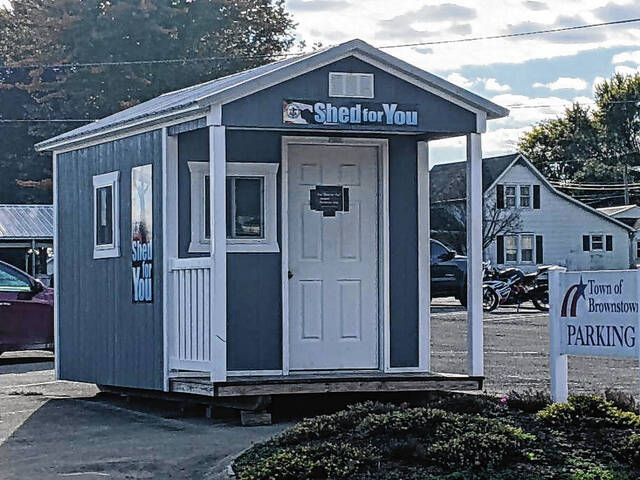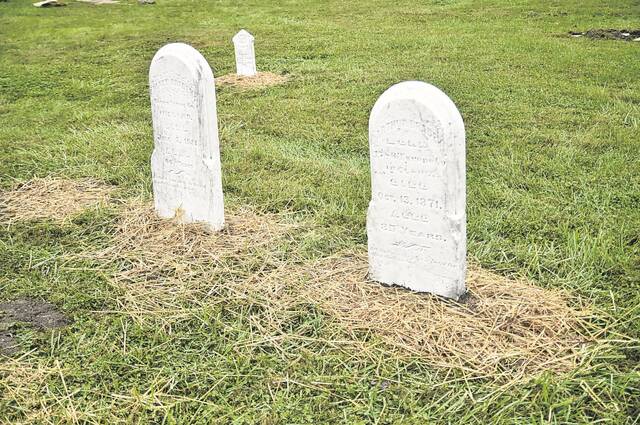
Tombstones restored by Graveyard Groomer at the Old Brownstown Cemetery, located at Water and Walnut streets.
Mitchell Banks | The Tribune
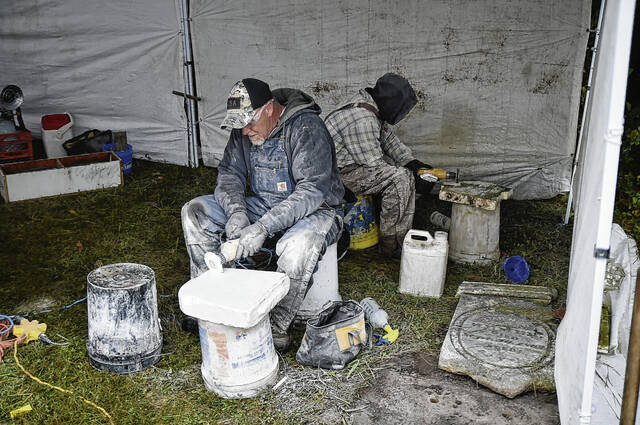
Todd Prifogle, front, and Larry Walters of Graveyard Groomer restore tombstones at the Old Brownstown Cemetery.
Mitchell Banks | The Tribune
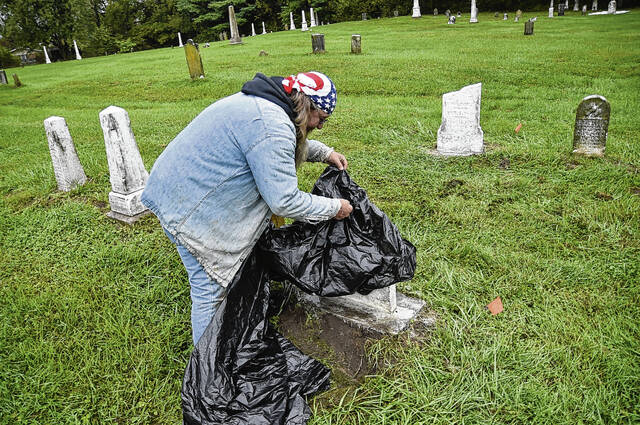
John “Walt” Walters of Graveyard Groomer puts a trash bag over a tombstone at the Old Brownstown Cemetery to keep it dry from rain for the restoration process.
Mitchell Banks | The Tribune
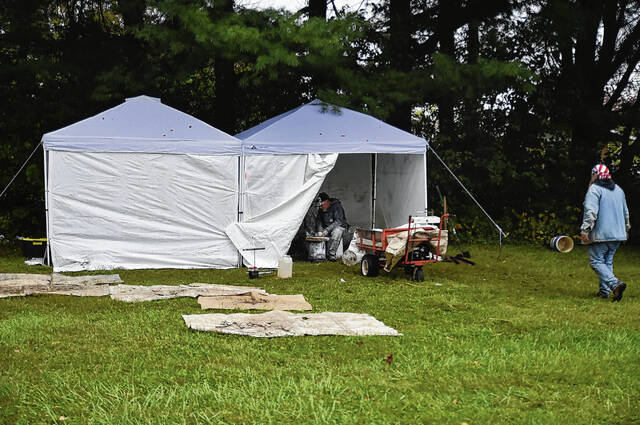
Tents set up at the Old Brownstown Cemetery for the restorers at Graveyard Groomer to work in the rain.
Mitchell Banks | The Tribune
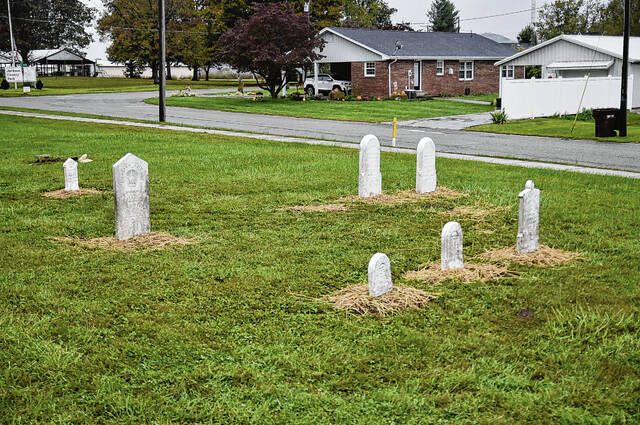
A group of tombstones restored by Graveyard Groomer at the Old Brownstown Cemetery.
Mitchell Banks | The Tribune
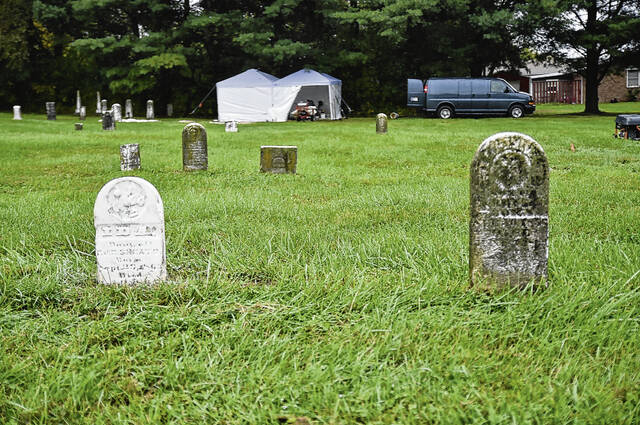
A restored tombstone, left, next to an unrestored one at the Old Brownstown Cemetery.
Mitchell Banks | The Tribune
BROWNSTOWN —A piece of the county’s history at Walnut and Water streets recently received a needed facelift.
Connersville-based Graveyard Groomer paid the town a visit last week to restore tombstones at the Old Brownstown Cemetery, located behind the Jackson County History Center.
Graveyard Groomer owner John “Walt” Walters, who is a cemetery restoration professional, and two of his employees, Todd Prifogle and Larry Walters, conducted the restoration work in the cemetery.
Approximately 240 people are buried in the cemetery, which was established April 8, 1816. That’s the same day Brownstown was founded and platted. For reference, Jackson County was formed Dec. 15, 1815, but Indiana did not become a state until Dec. 11, 1816.
According to the Jackson County History Center, many early burials were not marked. Most families recorded births, deaths and marriage dates in family Bibles that would be passed down for generations.
Walters, 65, said he planned on restoring the cemetery for one week this year and two weeks next year. If the cemetery isn’t restored after those two weeks, he said he plans on continuing to work in annual two-week increments until everything is done.
The company, which works on cemeteries across the country, restored tombstones at the cemetery in 2015. It also did some restoration at Miller Cemetery in Vallonia.
After the average tombstone is restored in the cemetery, it goes from looking gray, aged and eroded to a shining display of white marble.
“A lot of people don’t realize what can be done or how well it can be done,” Walters said.
Restoration of the cemetery began at the corner of the cemetery at Water and Walnut streets since it’s a visible area where people can see the improvements from the road.
When restoring a tombstone, Walters said you assess what is left, and hopefully, nothing is broken.
If anything is, he said an epoxy that joins stone to stone is used to put the tombstone back together.
From there, the tombstone is cleaned and placed where it first belonged.
Using ammonia and water to wash a tombstone is an easy way to clean one up, Walters said.
During the restoration process, Walters said there typically are cracks and voids in a tombstone. A compatible mortar is used to fill those spots.
Most of the tombstones in the Old Brownstown Cemetery are marble, which is common for 19th century tombstones.
Marble and limestone are the two kinds of stone that Graveyard Groomer typically deals with in restoration projects.
It wasn’t until the 20th century when granite, the most popular kind of material for tombstones, was commonly used for tombstones in cemeteries.
Walters called restoring graveyards “the most rewarding work he has ever done” and said he didn’t find his calling until he was 40.
It started for Walters in 1996 when he wanted a job with the Fayette County Highway Department. He said he eventually landed a job with the department by mowing graveyards in the summer.
The next summer, he “fell in love with old graveyards” and did his own research and restored cemeteries when he wasn’t mowing in a full-time position.
He would go on to restore 16 cemeteries in Fayette County and was asked to speak at the Indiana Trustees Association Conference.
After showing before-and-after pictures and sharing the success he was having in his county, so many people were asking Walters to restore tombstones that he resigned from his county position and started Graveyard Groomer.
Compared to the trades Walters learned in his life, he said none were as satisfying as restoring cemeteries.
“You get to walk away from something that might have been broken 70 or 80 or 90 years ago and be able to put it together and make it look respectable again,” he said. “I always think about people way back when that would visit a grave, shed tears, said prayers. Then they kind of fade away into history.”
On the bright side, Walters said genealogy is one of the fastest growing hobbies. With the internet, it’s also easier for anyone to find their ancestors and visit the graveyard where they’re buried.

